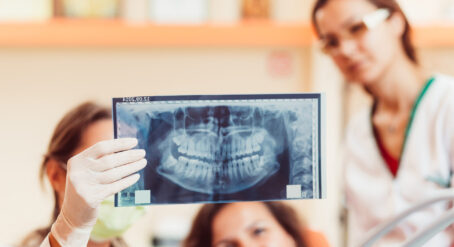Are braces only an option for kids? Does having braces mean I can no longer eat my favourite foods? Will my braces set off airport alarms?
It’s time to sort fact from fiction – ASO orthodontists weigh in on 10 of the most common myths surrounding braces…
Myth 1: Braces are only for children
FACT: A recent survey* revealed that 62% of Australian adults are considering orthodontic treatment. As a result, orthodontists from all over Australia are increasingly treating more and more adults with braces and other orthodontic treatments. In fact, some specialist orthodontic practices report 25-30% of new patients are over 18 years old.

Myth 2: Dentists and orthodontists offer the same services
FACT: 100% of orthodontists are dentists, but only 3% of dentists are orthodontists. Orthodontists and dentists share many similarities, but they actually work in very different ways. Dentists cover a broad range of oral health issues, while orthodontics is a specialisation within dentistry that focuses on issues such as straightening teeth and correcting improper bite patterns. Specialisation is what sets an orthodontist apart from a general dentist.
Myth 3: You must have a referral to see an orthodontist
FACT: While many Australians are referred to an orthodontist by their family dentist, a referral is not required to see an orthodontist. You can use the Find An Orthodontist tool on the ASO website to find a registered specialist orthodontist near you and book a consultation directly.
Myth 4: Braces set off metal detectors
FACT: If you’re worried about your braces setting off the alarms as you pass through the metal detectors at airport security, don’t be! Modern braces are very small and are made from extremely light metals that won’t trigger any alarms (or increase the likelihood of being struck by lightning, either!).
Myth 5: If you kiss with braces you’ll get stuck together
FACT: We’ve all heard the horror stories about two people with braces getting stuck together kissing, but rest assured, braces will have no impact on your relationships! It’s virtually impossible to ‘get stuck’ mid-kiss as modern braces are made of such fine material, and they’re certainly not magnetic!

Myth 6: Braces will give me a lisp
FACT: Because lingual (inside) braces are located near the tongue, they can take some time to get used to and may temporarily impact on speech. Rest assured, however, that all other treatments (metal and ceramic braces, as well as clear aligners such as Invisalign®, Spark® and 3M Clarity) won’t impede your speech.
Myth 7: My teeth will stay straight forever after braces
FACT: Without correct and consistent use of a retainer after orthodontic treatment, your newly straight teeth may start to move and become crooked again. Wearing a retainer long term is equally as important as the orthodontic treatment itself, protecting and maintaining your beautiful new smile into the future.
Myth 8: Braces are painful
FACT: While a little discomfort is normal when braces are first fitted or adjusted, most people find wearing braces completely comfortable. Modern braces and orthodontic wires have been developed and manufactured using advanced technology. Braces nowadays work more efficiently than ever and produce only a small amount of discomfort by applying very gentle but constant forces to move the teeth (for the majority of the time, this light pressure isn’t even noticeable!).
Myth 9: Having braces means I can no longer eat my favourite foods
FACT: You can still enjoy most of your favourite foods with braces – all it takes is a little extra care and preparation with foods that are hard or crunchy, such as chopping up apples into smaller pieces and removing meat off the bone before eating. Sticky lollies should be avoided though!

Myth 10: Children shouldn’t see an orthodontist until all of their adult teeth have erupted
FACT: Although early orthodontic treatment won’t be needed for all youngsters, taking your child to see an orthodontist between the ages of 7-10 will give the orthodontist a chance to assess the alignment of your child’s teeth and jaws and determine if and when early intervention is needed.
When it comes to the facts, only an orthodontist has been specifically trained and is the most qualified and experienced person to discuss issues to do with the alignment of teeth and jaws to ensure you, or your child, ends up with a healthy and confident smile. Use the Find An Orthodontist tool on the ASO website to find an orthodontist near you.
Myth 11: Orthodontic treatment is only cosmetic
FACT: While many people seek out orthodontic treatment to gain the confidence boost of a straight smile, that’s not the only reason to consider orthodontics. Correcting a bad bite or misaligned jaw can remove pain, help with sleep apnoea and ease pressure on your teeth so they don’t wear down unevenly.
Myth 12: Once you have your braces, you don’t necessarily need follow up appointments
FACT: Many people wrongly believe that their child’s braces are ‘set and forget’, and plan on skipping their regular appointments.
Skipping your regular orthodontic appointments may put your child’s teeth at risk and also prolong the length of their orthodontic treatment.Missing appointments may not allow the next stage in the treatment to be reached on-time, such as new archwires or the addition of elastics. While your orthodontist will let you know up-front how long the treatment should take, not adhering to the appointment schedule will unnecessarily prolong it and reduce its effectiveness.
Myth 13: Orthodontists only offer metal braces
FACT: If your child wants to have their teeth straightened but they don’t want traditional metal braces, you may think you should go to an alternative orthodontic provider so they can get something different. This is not the case. Orthodontists are the true experts in a wide variety of orthodontic treatment options, including plates, ceramic braces, lingual braces and clear aligner treatments such as Invisalign®, Spark® and 3M Clarity.
During your child’s assessment, your orthodontist will advise you about all of the best options for achieving the perfect smile and the costs involved. Traditional metal or clear braces remain a popular choice because they are very cost-effective and can perform the complete range of tooth movements. An alternative orthodontic provider may offer something different, but you may not see the desired results.
*Survey commissioned by the ASO via Pureprofile research using an online survey method. They survey was completed by over 1,000 18-59 year old Australian adults in December 2015










